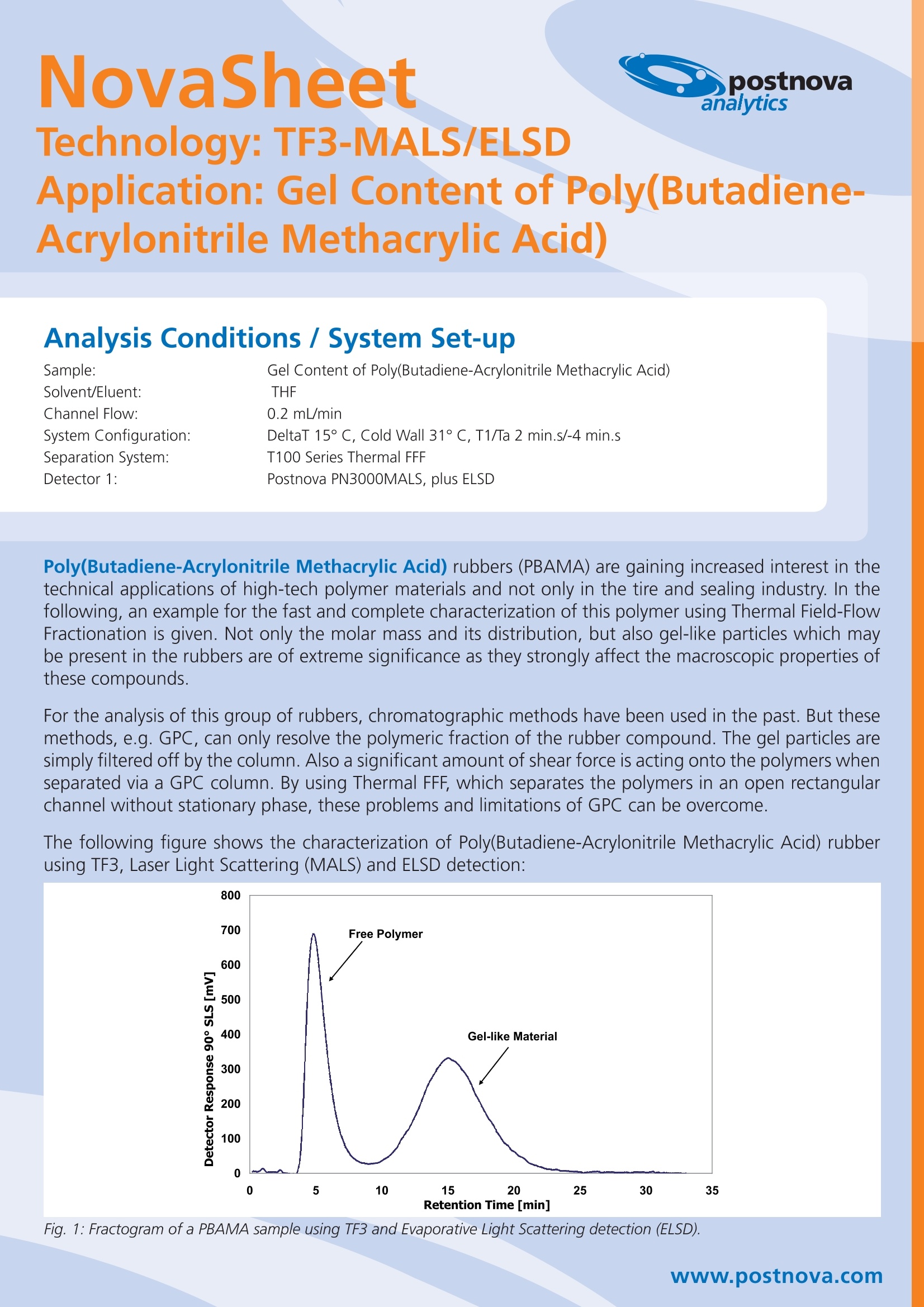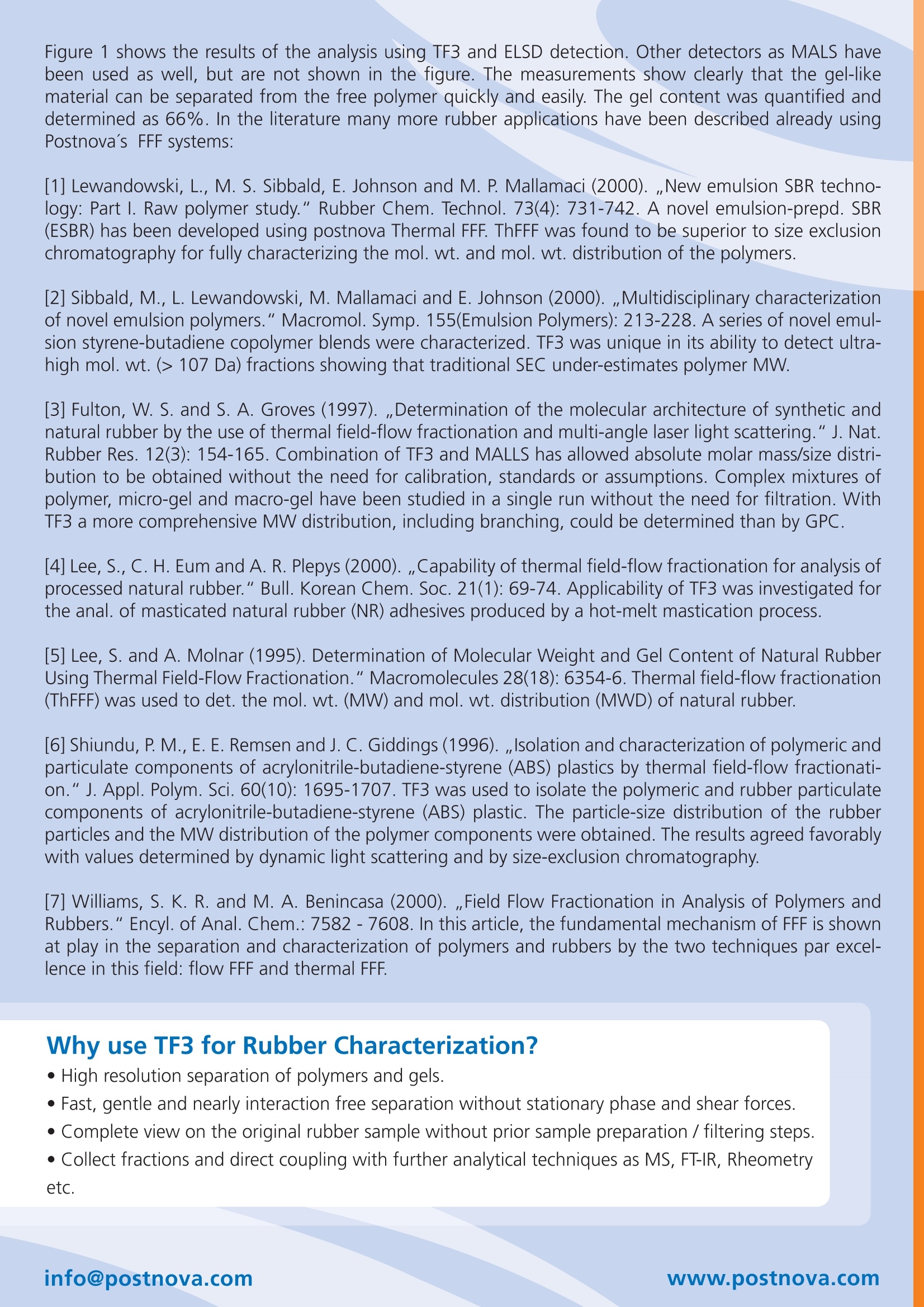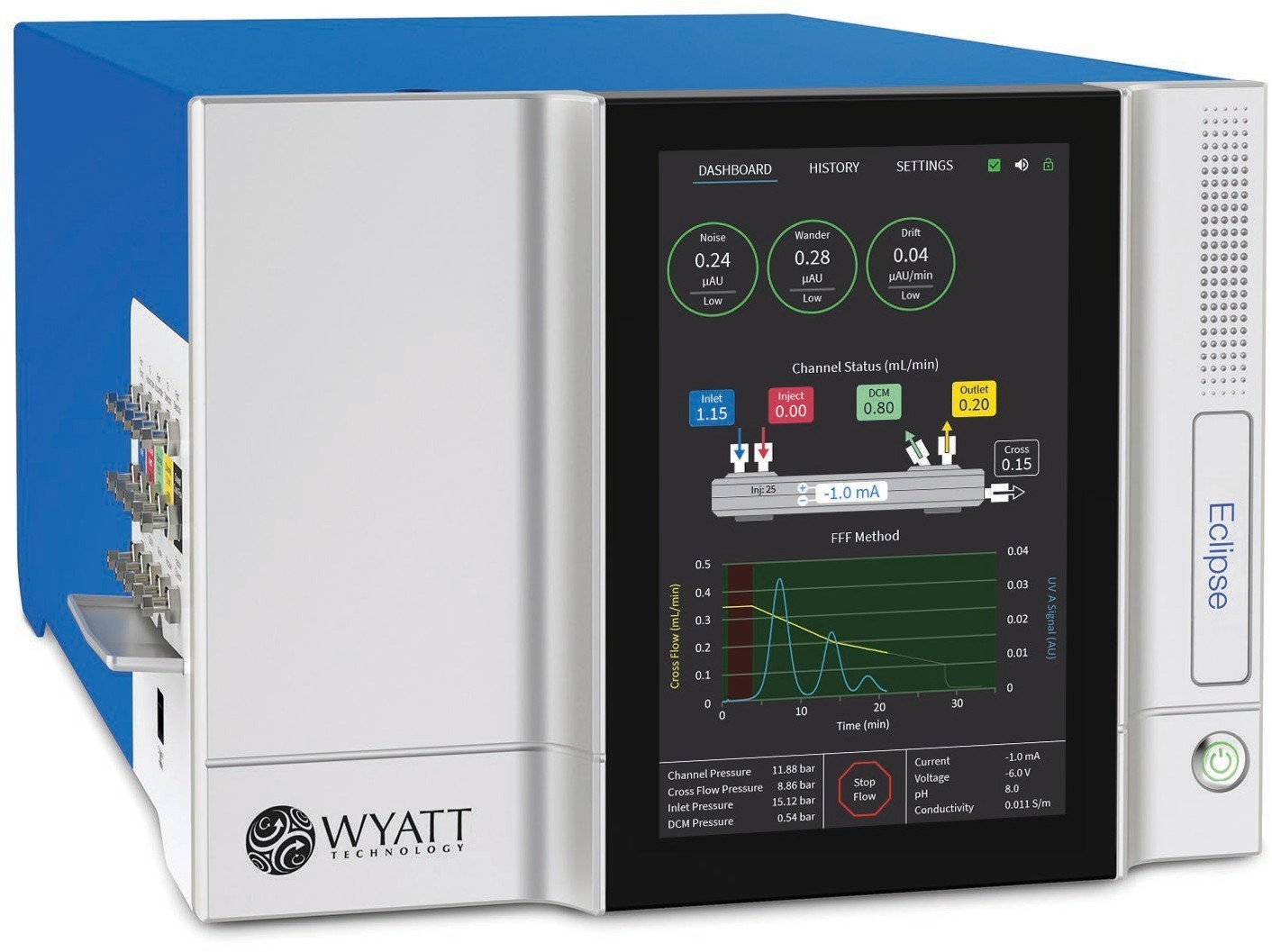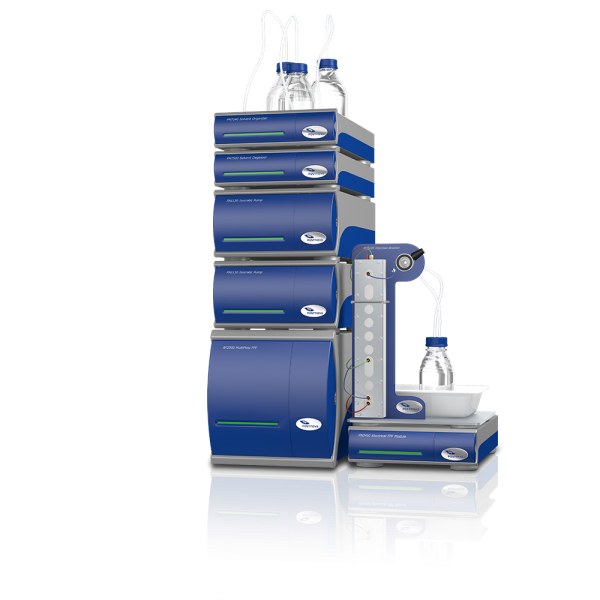方案详情文
智能文字提取功能测试中
NovaSheet Technology: TF3-MALS/ELSDApplication: Gel Content of Poly(Butadiene-Acrylonitrile Methacrylic Acid) Analysis Conditions / System Set-up Sample: Gel Content of Poly(Butadiene-Acrylonitrile Methacrylic Acid) Solvent/Eluent:lTHFChannel Flow:0.2 mL/minSystem Configuration:DeltaT 15°C, Cold Wall 31°C, T1/Ta 2 min.s/-4 min.sSeparation System:T100 Series Thermal FFFDetector 1:Postnova PN3000MALS, plus ELSD Poly(Butadiene-Acrylonitrile Methacrylic Acid) rubbers (PBAMA) are gaining increased interest in thetechnical applications of high-tech polymer materials and not only in the tire and sealing industry. In thefollowing, an example for the fast and complete characterization of this polymer using Thermal Field-FlowFractionation is given. Not only the molar mass and its distribution, but also gel-like particles which maybe present in the rubbers are of extreme significance as they strongly affect the macroscopic properties ofthese compounds. For the analysis of this groupof rubbers, chromatographic methods have been used in the past. But thesemethods, e.g. GPC, can only resolve the polymeric fraction of the rubber compound. The gel particles aresimply filtered off by the column. Also a significant amount of shear force is acting onto the polymers whenseparated via a GPC column. By using Thermal FFF, which separates the polymers in an open rectangularchannel without stationary phase, these problems and limitations of GPC can be overcome. The following figure shows the characterization of Poly(Butadiene-Acrylonitrile Methacrylic Acid) rubberusing TF3, Laser Light Scattering (MALS) and ELSD detection: Fig. 1: Fractogram of a PBAMA sample using TF3 and Evaporative Light Scattering detection (ELSD). Figure 1 shows the results of the analysis using TF3 and ELSD detection. Other detectors as MALS havebeen used as well, but are not shown in the figure. The measurements show clearly that the gel-likematerial can be separated from the free polymer quickly and easily. The gel content was quantified anddetermined as 66%. In the literature many more rubber applications have been described already usingPostnova's FFF systems: [1] Lewandowski, L., M. S. Sibbald, E. Johnson and M. P. Mallamaci (2000). ,,New emulsion SBR techno-logy: Part I. Raw polymer study." Rubber Chem. Technol. 73(4): 731-742. A novel emulsion-prepd. SBR((FSRR)ESBR) has been developed using postnova Thermal FFF. ThFFF was found to be superior to size exclusionchromatography for fully characterizing the mol. wt. and mol. wt. distribution of the polymers. [2] Sibbald, M., L.Lewandowski, M. Mallamaci and E. Johnson (2000). ,,Multidisciplinary characterizationof novel emulsion polymers."Macromol. Symp. 155(Emulsion Polymers): 213-228. A series of novel emul-sion styrene-butadiene copolymer blends were characterized. TF3 was unique in its ability to detect ultra-high mol. wt. (> 107 Da) fractions showing that traditional SEC under-estimates polymer MW. [3] Fulton, W. S. and S. A. Groves (1997).,,Determination of the molecular architecture of synthetic andnatural rubber by the use of thermal field-flow fractionation and multi-angle laser light scattering."J. Nat.Rubber Res. 12(3):154-165.Combination of TF3 and MALLS has allowed absolute molar mass/size distri-bution to be obtained without the need for calibration, standards or assumptions. Complex mixtures ofpolymer, micro-gel and macro-gel have been studied in a single run without the need for filtration. WithTF3 a more comprehensive MW distribution, including branching, could be determined than by GPC. [4] Lee, S., C. H. Eum and A. R. Plepys (2000). ,Capability of thermal field-flow fractionation for analysis ofprocessed natural rubber." Bull. Korean Chem. Soc. 21(1): 69-74.Applicability of TF3 was investigated forthe anal. of masticated natural rubber (NR) adhesives produced by a hot-melt mastication process. [5] Lee, S. and A. Molnar (1995). Determination of Molecular Weight and Gel Content of Natural RubberUsing Thermal Field-Flow Fractionation."Macromolecules 28(18): 6354-6. Thermal field-flow fractionation(ThFFF) was used to det. the mol. wt. (MW) and mol. wt. distribution (MWD) of natural rubber. [6] Shiundu, P.M., E. E. Remsen and J. C. Giddings (1996). ,,Isolation and characterization of polymeric andparticulate components of acrylonitrile-butadiene-styrene (ABS) plastics by thermal field-flow fractionati-on."J. Appl. Polym. Sci. 60(10):1695-1707. TF3 was used to isolate the polymeric and rubber particulatecomponents of acrylonitrile-butadiene-styrene (ABS) plastic. The particle-size distribution of the rubberparticles and the MW distribution of the polymer components were obtained. The results agreed favorablywith values determined by dynamic light scattering and by size-exclusion chromatography. [7] Williams, S. K. R. and M. A. Benincasa(2000). ,,Field Flow Fractionation in Analysis of Polymers andRubbers." Encyl. of Anal. Chem.:7582-7608. In this article, the fundamental mechanism of FFF is shownat play in the separation and characterization of polymers and rubbers by the two techniques par excel-lence in this field: flow FFF and thermal FFF. Why use TF3 for Rubber Characterization? · High resolution separation of polymers and gels. ·Fast, gentle and nearly interaction free separation without stationary phase and shear forces. · Complete view on the original rubber sample without prior sample preparation / filtering steps. ·Collect fractions and direct coupling with further analytical techniques as MS, FT-IR, Rheometryetc. www.postnova.com info@postnova.comwww.postnova.com
关闭-
1/2

-
2/2

上海积利科学仪器有限公司为您提供《橡胶中凝胶含量检测方案 》,该方案主要用于其他中凝胶含量检测,参考标准《暂无》,《橡胶中凝胶含量检测方案 》用到的仪器有热场场流分离仪。
我要纠错
推荐专场
相关方案





 咨询
咨询





